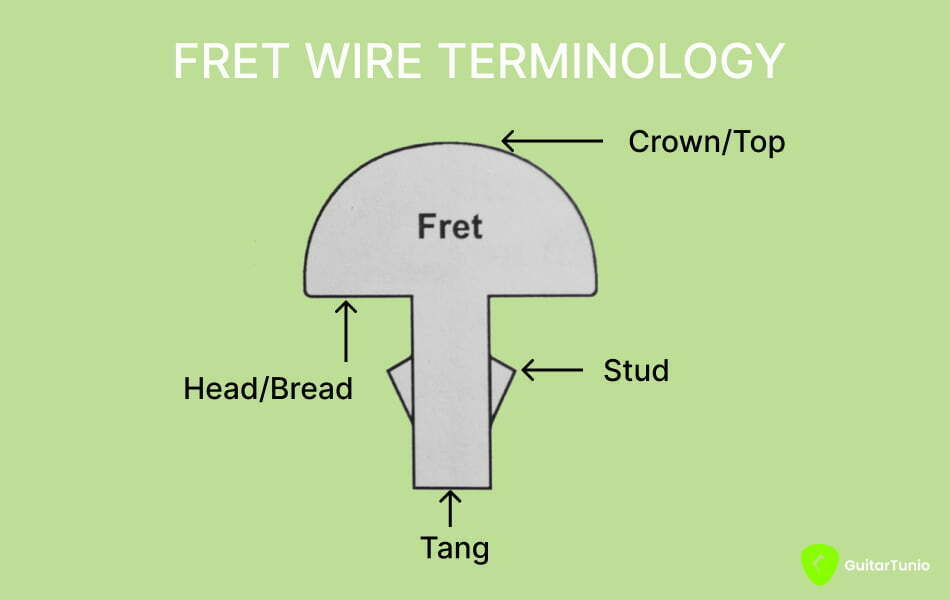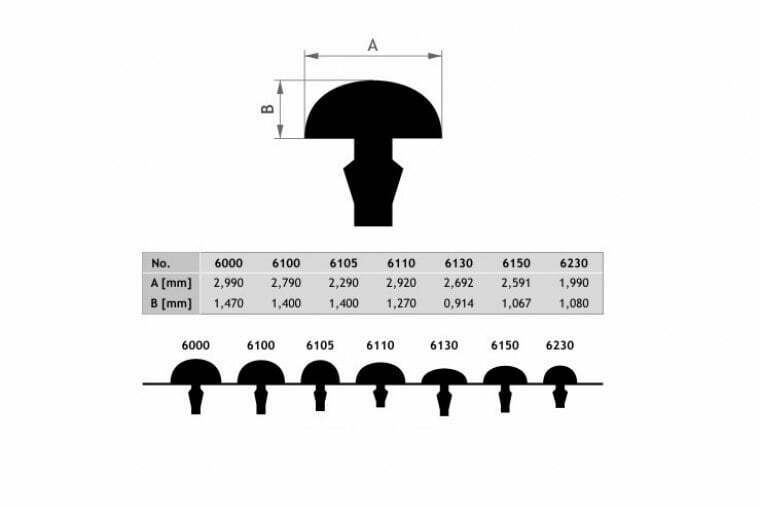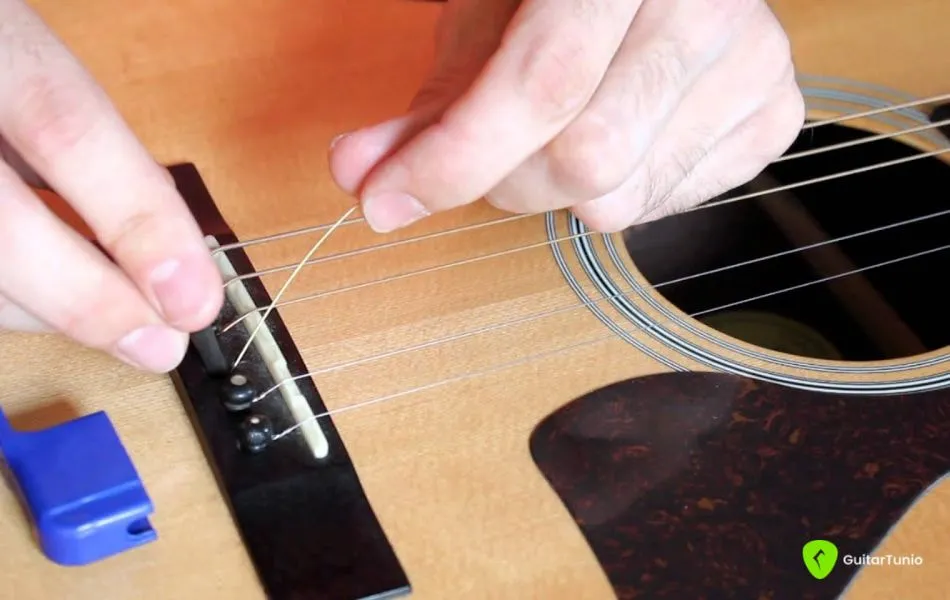Fret Sizes: Choosing the Right Size for You
When it comes to playing guitar or any other stringed instrument, the fret sizes can have a big impact on the overall playability and sound of the instrument. Frets are the metal strips that are placed along the neck of the guitar, and their size and height can greatly affect the way the instrument feels and plays. In the article, we’ll explore different types of fret sizes and a few things to keep in mind to choose the one that's right for you.
What is a fret wire?
Fret wire is a narrow metal strip that is installed on the fingerboard of the guitar. The fret wire is what the player presses down on to create the different notes and chords on the instrument. Fret wires are typically made from nickel or stainless steel, and come in a variety of sizes and shapes. Their size and shape can have a significant impact on the playability and sound of the instrument.

Anatomically, a fret consists of a round “crown” or “bead” linked to a “tang” with barbs/ studs on either side to secure into the fretboard. Each fret wire is installed onto the fingerboard by pressing it into slots pre-cut and then hammered down to secure it in place and ensure a tight fit.
Different fret sizes
There are various manufacturers of fret wire but by far the most popular and biggest is Dunlop. They produce 5 main fret wire sizes, and each has its own advantages and disadvantages. Let's take a closer look at these 5 types and what they can offer to players.

6230 - Vintage Frets
The smallest fret wire in the Dunlop lineup is the 6230 and it is often found on older and vintage guitars. 6230 fret wire is .078″ wide and .043″ high. The frets provide a more traditional feel and sound, and are popular among players who prefer a more classic playing style and play with a slide.
Vintage frets are typically easier to play chords on because they require less finger pressure to produce clear, clean notes. However, they may not be suitable for players who like to use a lot of force or emphasis in their playing, as the smaller size can make it more difficult to produce a strong, powerful sound.
Download Guitar Tunio to get your guitar in tune and improve your skills. The great guitar tuner is availble on the App Store and Google Play, check it out!
6105 - Modern narrow and tall
This is a sort of modern take of the smaller 6230, being thin but slightly taller and wider. It is usually around .090” wide and .055” tall. These 6105 are typically found on custom or high-end guitars. They are favored by players who enjoy a fast and responsive playing style. The narrow width of these frets allows for a greater degree of precision when playing, making it easier to execute complex techniques such as tapping or sweeping.
Their tall height also provides a greater degree of sustain and allows for a more aggressive attack on the strings. This can be particularly useful for players who use a lot of distortion or play in a heavier style.
One potential downside to 6105 frets is that they can be more difficult to play chords on, as the narrow width can make it more difficult to accurately place your fingers on the strings. This may be less of an issue for players who primarily use single-note lines or lead guitar techniques.
6150 - Vintage jumbo
The 6150 fret size is commonly known as “vintage jumbo” and is a rare find. It is much wider but not as tall as 6230. They are made from fret wire that is .102″ wide and .042″ high. These frets provide a greater degree of sustain and a more pronounced attack on the strings. The wider frets allow for a greater degree of control over the pitch and tone of the notes. Therefore, they are especially useful for players who use a lot of bending or vibrato techniques.
While the 6150 is often associated with vintage guitars, it is still used today on certain custom or high-end instruments. However, it may not be the best choice for every player or style of music, as the wider frets can make it more difficult to execute certain techniques or play chords accurately.
If you're considering a guitar with 6150 frets, try it out and see how it feels under your fingers. Pay attention to how the wider frets affect your playing and the sound of the instrument, and think about whether it's a good fit for your playing style and preferences.
6100 - Jumbo Frets
Jumbo frets are the largest frets available. They are often constructed on guitars that are designed for rock and metal music. They are typically .110″ wide and .055″ tall. Their height allows musicians to play with more force and emphasis, which is vital when playing heavy distortion or using a lot of vibratos.
Legato techniques, such as hammer-ons and pull-offs also may be straightforwardly played with jumbo frets, as the strings can be pushed down more easily with less effort. Conversely, some guitarists, find that the 6100 frets can make it harder to play chords since the wider frets can cause finger placement issues and require more finger pressure to produce clean, clear notes.
6130 - Medium Frets
The last one is the 6130 - medium fret size, which is often around .106″ wide and .036″ high. Medium frets are a popular choice for most players, as they offer a good balance between playability and sound. They are a middle-of-the-road option that provides enough height to allow for a decent amount of force and emphasis, while still being small enough to allow for good chord work.
6130 frets are also a good choice for players who like to use a variety of techniques in their playing, as they allow for both smooth legato playing and precise chord work. However, some players may find that medium frets don't offer enough height for their playing style, especially if they prefer to play with a heavier touch.
Choosing the Right Fret Size
The choice of fret size comes down to personal preference and playing style. When choosing the right guitar fret size, it's important to consider the type of music you play, as well as the techniques you use. If you prefer to play with a heavy touch and use a lot of bending and vibrato, 6100 frets may be the best choice for you. If you tend to play in a more traditional style and use a lot of chord work, 6230 or 6130 may be a better option.

It's also a good idea to experiment with different types of frets before making a final decision, as the feel and sound of each type of fret can vary depending on the specific instrument and the player's individual preferences. When trying out different fret sizes, pay attention to how the frets feel under your fingers, as well as how they affect the sound of the instrument. Does the fret size make it easier or more difficult to play certain techniques or chords? Does it affect the sustain or intonation of the notes?
It's also essential to consider the size of your hands when choosing fret wire size. If you have smaller hands, you may find that larger frets are more difficult to play, while players with larger hands may prefer the added height and width of jumbo frets.
In addition to the size of the frets, the material they are made from can also influence the playability and sound of the instrument. Most frets are made from nickel or stainless steel, although some higher-end instruments may use other materials such as gold or platinum.
Conclusion
In conclusion, you will need to consider some factors to choose the right guitar fret size for you. Don’t be afraid to try out different options before making a final decision. With the right fret size and a little bit of practice, you'll be well on your way to mastering your instrument and creating the perfect sound for your music.
Visit our blog to read more useful articles and gain more knowledge to improve your skills and level.







